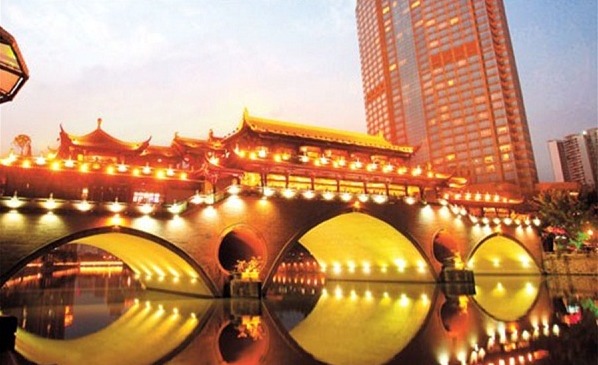Easygoing break in laid-back Chengdu
 0 Comment(s)
0 Comment(s) Print
Print E-mail Shanghai Daily, December 10, 2015
E-mail Shanghai Daily, December 10, 2015
|
The well-known Anshun Bridge (also known as "Marco Polo" Bridge) spans the Jinhe River.(Pete Wong) |
There is a popular local saying that goes: "When a married man arrives in Chengdu, he wishes he were still single."
The capital of Sichuan, with a population of over 11 million, is renowned not just for its spicy cuisine but also for its beautiful women. Some credit the local chillies, which are said to purge the body of toxins, resulting in purer complexions. Others say it's the mild weather.
Whatever the reason, Chengdu is uniquely different. Unlike the pressure-cooker environment of cities like Beijing or Guangzhou, the pace in Chengdu is more laid-back. As evening settles, locals are out walking their dogs, setting up mahjong table or dancing in local parks.
There's so much to see and do in Chengdu.
• Old towns and temples
Within the city proper, near the Wuzhou Temple, is the popular Jinli Street. Start your tour with a visit to the temple, a memorial to the hero Zhuge Liang, who was immortalized in the classic "Romance of the Three Kingdoms."
When the temple closes for the day, take a stroll along the old cobbled streets of Jinli. In the evening, the place comes alive with the buzz of teahouses, cafes, restaurants and shops. As with all tourist spots, prices here tend to be more expensive than elsewhere. A less crowded alternative would be the Wenshu Fang old quarter beside the Wenshu Temple.
About an hour's journey outside Chengdu is Luodai, also known as Hakka Ancient Town because about 90 percent of its residents are of Hakka origin. Luodai's history dates back to the Han Dynasty (202BC-AD220), and the houses, courtyards and streets are in typical Qing Dynasty (1644-1911) style. If you have even more time, travel 90 kilometers west to Pingle — which the locals pronounce "ping-lo" in dialect -— an old village frozen in time.
For peace and solitude, head toward the ancient Taoist Qingyang Temple where you can chill out over Sichuan tea and the background incantation of monks.
• Meeting giant pandas
Sichuan Province is home to China's giant pandas, and no trip to this region of the country would be complete without a close-up encounter with these beloved animals. The best place to view pandas is the Chengdu Research Center of Giant Panda Breeding, located about 10 kilometers from downtown. A good tour guide should be able to lead you through the meandering paths and directly to the panda enclosures.
Bragging rights to cuddling a panda, with a photo to prove it, will set you back a whopping 1,000 yuan (US$155.8). Otherwise, the entrance fee to the center is just 58 yuan, and a taxi ride from downtown shouldn't cost more than 60 yuan. It's best to arrive before 8:30am, when it's feeding time and the pandas are most active.
• Eating out like a local
Mahjong is popular in the neighborhoods of Chengdu, but if you want to rub elbows with the local, head for restaurants serving traditional hotpot, or mala huoguo. While in Chengdu, be sure to try other local specialties like Kung Pao chicken, mapo tofu and Dandan noodles. Famous restaurants for Sichuan hotpot include Huang Cheng Lao Ma (www.hclm.net), Shi Zi Lou (2 Wannian Road) and Tan Yu Tou (227 Qingyang Street, Qingyang District). Grandma Chen's Mapo Tofu (19 Qinghua Lu) is also legendary.
Initiation into the Chengdu lifestyle is not quite complete without a visit to one of the city's famous teahouses (chalou) for Sichuan green tea (chuancha). There is one at every corner, but the more popular venues are in People's Park, River View Bamboo Park near Sichuan University, Yue Lai (2 Yinhe Beijie, beside the Jinjiang Theatre) and Shun Xing (3/F, Chengdu International Exhibition Center, 258 Shawan Road). Both Yue Lai and Shun Xing feature Sichuan opera performances while you sip your brew.
• Check out the flower villages
There is a sense of joyful exuberance when spring rolls around, especially for the younger folks. Many head outdoors to enjoy the refreshing cool weather and sunshine. Some can be seen playing mahjong, a local obsession, under the peach blossoms, while families and friends gather for picnics.
A popular getaway, about 15 kilometers southeast of the city, is Sansheng Flower Village. Locals go there not just to enjoy the floral beauty but also for a breath of fresh air. Local guesthouses provide nice weekend getaways. You won't find this information on the tourist maps, so just hop into a taxi and head to the village. The 30-minute taxi ride should not cost more than 50 yuan.
Other flower villages east of the city are Longquan and the Hakka Xinghua Village in the Qingbaijiang District, where the annual Apricot Flower Festival is held, starting from the end of March.








Go to Forum >>0 Comment(s)